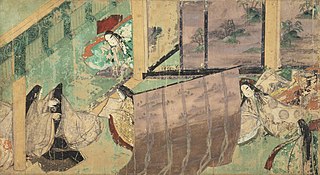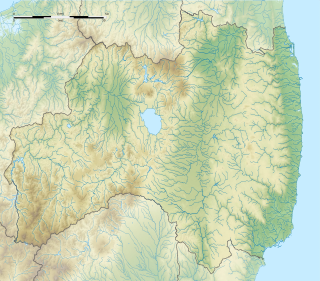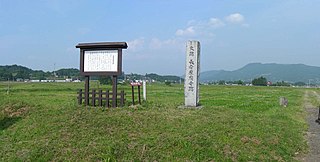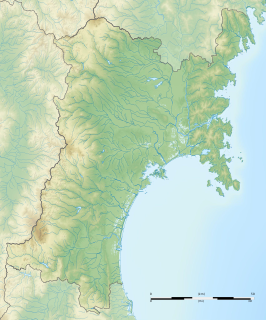 W
WThe Heian period is the last division of classical Japanese history, running from 794 to 1185. The period is named after the capital city of Heian-kyō, or modern Kyoto. It is the period in Japanese history when Buddhism, Daoism and other Chinese influences were at their height. The Heian period is also considered the peak of the Japanese imperial court and noted for its art, especially poetry and literature. Although the Imperial House of Japan had power on the surface, the real power was in the hands of the Fujiwara clan, a powerful aristocratic family who had intermarried with the imperial family. Many emperors actually had mothers from the Fujiwara family. Heian (平安) means "peace" in Japanese.
 W
WThe Beizanji Sutra Mounds is a Kamakura period archaeological site located in what is now part of the city of Sukagawa, Fukushima Prefecture in the Tōhoku region of Japan. The site was designated a National Historic Site of Japan in 1937. and expanded in 1977.
 W
WThe Chōjagadaira Kanga ruins is an archaeological site with the ruins of a Nara to Heian period government administrative complex located in what is now on the border of the cities of Nasukarasuyama, and Sakura in Tochigi prefecture in the northern Kantō region of Japan. It is protected by the central government as a National Historic Site from 2009.
 W
WChōjagahara temple ruins is an archaeological site with the ruins of a late Heian period Buddhist temple located in what is now the city of Ōshū, in northern Japan. The site was protected by the central government as a National Historic Site in the year 2002.
 W
WThe Daikichiyama Tile Kiln ruin is an archaeological site with the remains of a late Nara period to early Heian period roof tile production site located in what is now the city of Ōsaki, Miyagi Prefecture in the Tōhoku region of northern Japan. It has been protected by the central government as a National Historic Site since 1976.
 W
WThe Dōnomae ruins is an archaeological site containing the ruins of a Heian period fortified settlement located in what is now part of the city of Sakata, Yamagata in the Tōhoku region of Japan. The site was designated a National Historic Site of Japan in 1979.
 W
WThe Furushida-Higashi ruins is an archaeological site containing the ruins of a large-scale Heian period residence located in what is now part of the city of Yonezawa, Yamagata in the Tōhoku region of northern Japan. The site was designated a National Historic Site of Japan in 2000.
 W
WGokuraki-ji (極楽寺) is a Buddhist temple located in the former Esahi District of what is now the city of Kitakami, in Iwate Prefecture in the far northern Tōhoku region of Japan, located at the base of the 244 metres (801 ft) Mount Kunimi. The temple belongs to the Shingon sect and its main image is a statue of Amida Nyōrai.
 W
WThe Goshogawara Sue Pottery Kiln Site is an archaeological site consisting of the remains of Heian period kilns located in what is now the city of Goshogawara, Aomori Prefecture in the Tōhoku region of northern Japan. It is protected by the central government as a National Historic Site.
 W
WHaji pottery is a type of plain, unglazed, reddish-brown Japanese pottery or earthenware that was produced during the Kofun, Nara, and Heian periods of Japanese history. It was used for both ritual and utilitarian purposes, and many examples have been found in Japanese tombs, where they form part of the basis of dating archaeological sites.
 W
WThe Higashiyama Kanga ruins is an archaeological site with ruins of a Nara period to early Heian period government administrative complex located in what is now part of the town of Kami in Kami District, Miyagi prefecture in the Tōhoku region of far northern Honshu, Japan. The site was proclaimed a National National Historic Site in January 1999.The site was excavated in 1986. It is roughly contemporary with Taga Castle to the southeast.
 W
WHikime kagibana describes a feature of illustration continuing in the repertoire of Japanese Art from the Heian period through the Kamakura period, most notably in yamato-e e-maki. Its influence can be traced right up the Edo-period ukiyo-e or later.
 W
WThe Hotta-no-saku ruins is an archaeological site containing the ruins of a large-scale Heian period josaku-style fortified settlement located in what is now part of the cities of Daisen and Misato in the Tōhoku region of Japan. The site was designated a National Historic Site of Japan in 1931. The site is maintained as an archaeological park with some reconstructed buildings.
 W
WIji Castle was jōsaku-style Japanese castle built during late Nara period. Its ruins are now an archaeological site in the city of Kurihara, Miyagi prefecture in the Tōhoku region of northern Japan. The site has been protected as a National Historic Site on August 27, 2003.
 W
WIsawa Castle was an early Heian period jōsaku-style Japanese castle located in what is now part of the city of Ōshū, Iwate in the Tōhoku region of far northern Honshu, Japan. The site was proclaimed a National National Historic Site in 1922.
 W
WThe Izumi Kanga ruins is an archaeological site with the ruins of a Heian period government office complex located in former Haramachi town in what is now part of the city of Minamisōma, Fukushima prefecture in the southern Tōhoku region of northern Honshu, Japan. It has been protected by the central government as a National Historic Site since 2010.
 W
WKamiichi Kurokawa Sites is a group of archaeological site in the town of Kamiichi, Toyama Prefecture in the Hokuriku region of Japan. It has been protected by the central government as a National Historic Site since 1981.
 W
WThe Kamikōnushi・Mobara kanga ruins is an archaeological site with the ruins of a Nara to Heian period government administrative complex located in what is now on the border of the town of Kaminokawa, with the city of Utsunomiya in Tochigi prefecture in the northern Kantō region of Japan. It has been protected as a National Historic Site from 2003. The Kita-Kantō Expressway cuts directly across the site.
 W
WKemari (蹴鞠) is an athletic game that was popular in Japan during the Heian period. It resembles a game of football (soccer) or hacky sack. Kemari has been revived in modern times.
 W
WLegend of the Millennium Dragon is a 2011 Japanese anime film.
 W
WMinamoto (源) was one of the surnames bestowed by the Emperors of Japan upon members of the imperial family who were excluded from the line of succession and demoted into the ranks of the nobility from 1192 to 1333. The practice was most prevalent during the Heian period, although its last occurrence was during the Sengoku period. The Taira were another such offshoot of the imperial dynasty, making both clans distant relatives. The Minamoto clan is also called the Genji (源氏), or less frequently, the Genke (源家), using the on'yomi reading for Minamoto.
 W
WNagare temple ruins is an archaeological site with the ruins of a Heian period Buddhist temple located in what is now the town of Tanagura, Fukushima, in the southern Tōhoku region of Japan. The temple no longer exists, but the temple grounds were designated as a National Historic Site by the Japanese government in 2014.
 W
WThe Nasu Kanga ruins is an archaeological site with the ruins of a Heian period government administrative complex located in what is now part of the town of Nakagawa, Tochigi prefecture in the northern Kantō region of Japan. It has been protected as a National Historic Site from 1976.
 W
WNegishi Kanga ruins is an archaeological site with the ruins of a Heian period local government administrative complex and Buddhist temple, built over a Jōmon period settlement, located in what is now part of the city of Iwaki, Fukushima prefecture in the southern Tōhoku region of northern Honshu, Japan. It has been protected by the central government as a National Historic Site since 2005.
 W
WŌchiwatoge temple ruins is an archaeological site with the ruins of a Heian period Buddhist temple located in what is now the city of Kosai, Shizuoka, Japan. The temple no longer exists, but the temple grounds were designated as a National Historic Site by the Japanese government in 2001.
 W
WThe Ōtoriiyama ruins is an archaeological site containing a large Heian period jōsaku-style fortification located in what is now part of the city of Yokote, Akita in the Tōhoku region of Japan. The site was designated a National Historic Site of Japan in 2010.
 W
WThe Sanjusangendō Kanga ruins is an archaeological site with the ruins of a Heian period government administrative complex located in what is now part of the town of Watari, Miyagi prefecture in the Tōhoku region of far northern Honshu, Japan. It is protected by the central government as a National Historic Site.
 W
WThe Shida Gunga ruins is an archaeological site containing the ruins of the Nara to early Heian period government administrative complex for Shiga District, Suruga Province, located in what is now part of the city of Fujieda, Shizuoka in the Tōkai region of Japan. The site was designated a National Historic Site of Japan in 1980.
 W
WThe Shimotsuke Provincial Capital ruins is an archaeological site with the ruins of a Nara to Heian period government administrative complex located in what is now part of the city of Tochigi, Tochigi prefecture in the northern Kantō region of Japan. Identified as the ruins of the kokufu of Shimotsuke Province, the site is protected by the national government as a National Historic Site from 1982.
 W
WShinano Kokubun-ji (信濃国分寺) is a Tendai sect Buddhist temple located in the city of Ueda, Nagano, Japan. Its honzon is Yakushi Nyorai. It is the successor to one of the provincial temples established by Emperor Shōmu during the Nara period for the purpose of promoting Buddhism as the national religion of Japan and standardising control of the Yamato rule to the provinces. The archaeological site with the ruins of the ancient temple grounds was designated as a National Historic Site by the Japanese government in 1974.
 W
WShinden-zukuri (寝殿造) refers to the style of domestic architecture developed for palatial or aristocratic mansions built in Heian-kyō in the Heian period (794–1185), especially in 10th century Japan.
 W
WShiwa Castle was an early Heian period jōsaku-style Japanese castle located in what is now part of the city of Morioka, Iwate Prefecture in the Tōhoku region of far northern Honshu, Japan. The site was proclaimed a National Historic Site of Japan in 1979.
 W
WSōja (総社) is a type of Shinto shrine where the kami of a region are grouped together into a single sanctuary. This "region" may refer to a shōen, village or geographic area, but is more generally referred to a whole province. The term is also occasionally called "sōsha". The sōja are usually located near the provincial capital established in the Nara period under then ritsuryō system, and can either be a newly created shrine, or a designation for an existing shrine. The "sōja" can also be the "ichinomiya" of the province, which themselves are of great ritual importance.
 W
WSue pottery was a blue-gray form of high-fired pottery which was produced in Japan and southern Korea during the Kofun, Nara, and Heian periods of Japanese history. It was initially used for funerary and ritual objects, and originated from Korea to Kyūshū. Although the roots of Sueki reach back to ancient China, its direct precursor is the grayware of the Three Kingdoms of Korea.
 W
WTakase Site (高瀬遺跡) is an archaeological site in the city of Nanto, Toyama Prefecture in the Hokuriku region of Japan containing the ruins of a shōen from the early Heian period. It has been protected by the central government as a National Historic Site since 1981. It was the first ruin of a shōen to receive such status.
 W
WThe Takayashikidate ruins is an archaeological site containing the ruins of a fortified settlement dating to the Heian period in what is now part of the city of Aomori, Aomori Prefecture, in the Tōhoku region of northern Japan. The ruins were designated a National Historic Site in 2012 by the Japanese government.
 W
WTokutan Castle was an early Heian period jōsaku-style Japanese castle located in what is now the town of Yahaba in Shiwa District, Iwate Prefecture in the Tōhoku region of far northern Honshū, Japan. The site was proclaimed a National Historic Site of Japan on 5 August 1969.
 W
WThe Yokodaidō Steel Production Site is an archaeological site in the city of Minamisōma, Fukushima Prefecture, in the southern Tōhoku region of northern Japan containing the ruins of a large-scale a late-Nara period to early Heian period bloomery (ironworks). The site was designated a National Historic Site of Japan in 2011 by the Japanese government.